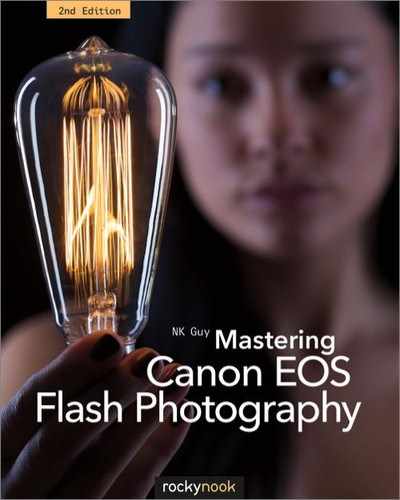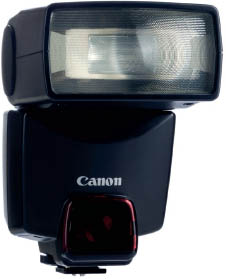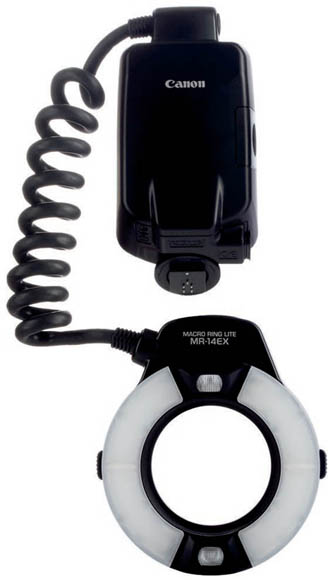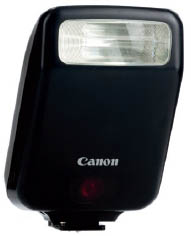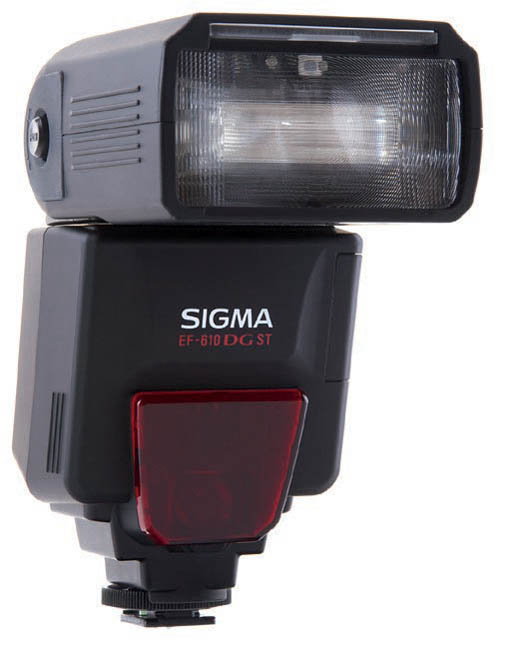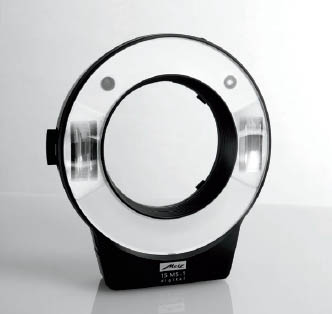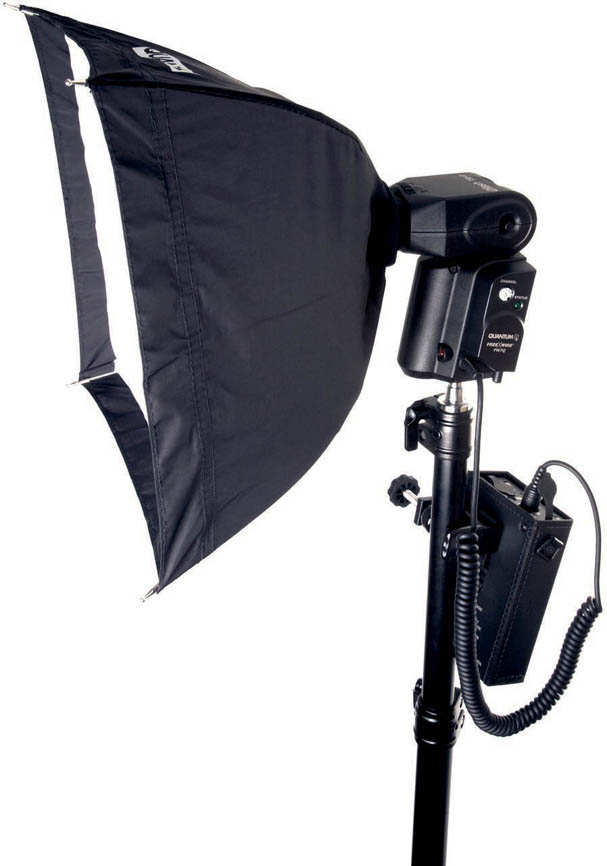Appendix A: Flash Units for Canon EOS
Speedlites for film and digital cameras (E-TTL)
These flash units are compatible with all Canon EOS type A cameras that support E-TTL and E-TTL II metering. Some can revert to legacy TTL mode for film cameras. However, the 90EX, 270EX, 270EX II, 320EX, 430EX III, and 430EX III-RT are E-TTL only.
Speedlite 90EX
This miniature unit seems like a fairly useless add-on for the tiny EOS M series of mirrorless cameras. It’s powered by twin AAA cells, giving it a very ponderous recycle time. But it has a trick up its sleeve—it can serve as an optical wireless E-TTL master, making it a portable and affordable solution for wireless flash, albeit one with limited range. Canon should have marketed this one as a Speedlite Transmitter.
It’s almost devoid of physical buttons, and requires ESC menu control. It has no red AF assist light. When in optical wireless master mode it won’t provide any scene-illuminating light. E-TTL only.
Speedlite 220EX
The E-TTL successor to the Speedlite 200E has slightly greater range and a few E-TTL functions. It’s a very small unit for cameras that lack built-in flash. It can neither tilt nor swivel, nor serve as a wireless E-TTL slave. Fixed 28 mm coverage, and the red AF assist light covers the center point only. Discontinued.
17.1 220EX
Speedlite 270EX
The 220EX’s replacement has a tilting head and a two-position hand-operated zoom. Unfortunately, it lacks a red AF assist light and instead pulses its main tube annoyingly in low light conditions. It uses only two AA batteries, so it’s quite compact but recycles slowly.
Lacking the usual physical controls, most of the 270EX’s features are only available on cameras that have Speedlite menu control (ESC). E-TTL only. Discontinued.
17.2 270EX
The 270EX II adds a significant new feature—optical wireless slave mode, though group A only. This makes the 270EX II the perfect partner for the 90EX for the casual photographer—you simply carry a 90EX and one or two 270EX II’s, and you’ve got a lightweight low-power multi-flash setup. The 270EX II has a side-mounted button that lets the unit emit the same IR commands as a Canon RC-1, RC-5, or RC-6 controller, so you can use the flash unit as a remote controller and take photos without walking back to the camera.
Speedlite 320EX
Unlike its smaller brethren, the 320EX is powered by four AA batteries and has physical controls for optical wireless slave mode. It also works with a camera’s ESC menu control. Its head can be swiveled and rotated, but its zoom is limited: its head can be manually extended to a second position for use with longer lenses. It has a white LED, which can serve as an autofocus light if the camera is in Live View mode, or it can be used as a modest light source for video. Finally, it has an RC-1/5/6 compatible remote control like the 270EX II.
Speedlite 380EX
An early EX flash unit, the 380EX has three significant drawbacks. First, while it can tilt its zoomable head, it can’t swivel. Second, it can’t use wireless E-TTL. Third, it has no flash exposure compensation for cameras that lack FEC.
Other than those limitations, it’s a mid-sized flash unit with the usual E-TTL abilities. Its red AF assist light covers the central point only. It has no manual controls of any kind. Discontinued.
17.3 380EX
Speedlite 420EX
The first affordable EX unit with optical wireless slave capabilities. The 420EX lacks a screen or manual control but can zoom, tilt, and swivel and supports most E-TTL functions. Its red AF assist light covers seven focus points, and it has modeling light support. It lacks on-board controls for flash exposure compensation. Can be confused with the older 420EZ.
No manual controls for either flash output or zoom. Discontinued.
17.4 420EX
Speedlite 430EX
A definite upgrade to the 420EX with an LCD, manual controls (output, zoom, and curtain sync), a pull-out diffuser panel, single-button tilt and swivel, and custom functions. In addition to optical wireless slave functions, it has digital features such as sensor size compensation.
Compared to the 580EX, it lacks optical wireless master capabilities, stroboscopic operation, weatherproofing, battery pack socket, and has lower output. Its red AF assist covers up to nine focus points. Can be confused with the older 430EZ. Full manual controls. Discontinued.
Speedlite 430EX II
The 430EX II adds a metal foot with quick-release lock and compatibility with camera menus. It’s quieter and a bit faster at recycling. Its main drawback is that engaging optical E-TTL slave mode requires time-consuming menu button presses, rather than the simple switch on the 420EX or 430EX.
A good product, but optical E-TTL slave only. Full manual controls. Discontinued.
17.5 430EX
17.6 430EX II
Speedlite 430EX III-RT
The 430EX III-RT boasts radio compatibility, and is the first midrange Canon flash unit to support master control (though only in radio mode—it can act solely as an optical slave). A dot-matrix display with an easy-to-use menu interface controlled by a dial (superior to the 600EX-RT system, in my opinion), compact and portable, full manual options.
It’s basically an excellent product, lacking only certain pro features such as a battery pack socket. The non-radio 430EX III is available in a handful of markets.
Speedlite 550EX
The 550EX was the first flagship of the E-TTL era. It introduced optical wireless E-TTL control, and it can serve as a master or a slave unit. It’s the largest and heaviest of all the 500 series flash units, and has full manual controls and and stroboscopic output. No custom functions.
Bulky, is noisy in operation, and its buttons are recessed and awkward to operate. Discontinued.
17.7 550EX
17.8 580EX
17.9 580EX II
Speedlite 580EX
The most compact of the 500 series units, the 580EX also introduces an improved interface with easier to operate buttons, custom functions, and a dial configuration. It’s a nice upgrade from the chunky 550EX. Like its predecessor, it has a quick and easy physical switch for engaging optical wireless master and slave modes, making it a popular buy on the used market. Full manual controls.
It has an old-style rotating wheel foot, and is not ESC compatible. Discontinued.
Speedlite 580EX II
The 580EX II adds weatherproofing, a quick-release foot design, menu control from compatible cameras (ESC), single-button tilt and swivel, and silent recycling. It’s slightly larger than the 580EX. Full manual controls and a PC socket.
Unfortunately, engaging its optical wireless mode requires fiddly and time-consuming button holds rather than the simple switch found on its predecessors. Discontinued.
Speedlite 600EX-RT
The current top dog in the lineup, the 600EX-RT has all the features of its flagship predecessors, with the game-changing addition of truly solid radio wireless. Other new features include a dot-matrix LCD screen, a “self-cleaning” foot design, an optional filter holder with automatic recognition of two CTO filter types, optional remote camera control, a beeper, and a good wireless interface. Despite having all these features, it’s still backwards compatible with optical wireless E-TTL and even with film-era TTL metering.
It has almost the same light output as its predecessors—it just has a longer zoom reach. Many of the more desirable radio wireless features, such as 5-group support and high-speed sync, don’t work with older cameras that aren’t radio aware. The non-radio 600EX is available in a handful of markets.
A compact master unit for optical wireless E-TTL. Cannot produce scene-illuminating light. Can control slave units in small rooms, but severely hobbled by weak range and its inability to control units in group C. It has a red assist light for low-light AF. Uses a lithium 2CR5 battery.
17.10 ST-E2
Speedlite Transmitter ST-E3-RT
The ST-E3-RT is the radio wireless E-TTL successor to the ST-E2. Like its ancestor, it can’t produce any scene-illuminating light, but unlike the ST-E2, the ST-E3-RT has full control over all radio wireless features. This includes manual flash, 5-group control, remote shutter release, and so on. Unlike the 600EX-RT, the Speedlite Transmitter does not support optical wireless E-TTL and sadly lacks a red AF assist light. It runs off two AA cells and has a dot-matrix display.
Macro flash
There are four Speedlites designed specifically for macro (closeup) photography.
17.11 ML-3
Speedlite ML-3 Ring Lite
This film-only macro unit comes in two pieces joined by a detachable cable. The body fits on the hotshoe, and the head fits around the end of a lens. The two tubes are curved but do not cover a full 180°. Because of the modeling lights, each tube has an arc of roughly 150°. It fits directly onto Canon 50 mm 2.5, 100 mm 2.8 macro, 100 mm 2.8 USM macro, and MP-E 65 mm lenses. An adapter ring is needed for the 180 mm 3.5L macro. It does not fasten onto the filter threads, and so is not directly compatible with third-party macro lenses or other non-macro lenses.
Unfortunately, the ML-3 is only useful for film camera (TTL) users. No manual controls, and therefore of very limited value today. No way of adjusting the ratio between the two tubes. Discontinued.
17.12 MR-14EX
Speedlite MR-14EX Ring Lite
Similar to the ML-3, but updated for E-TTL. Non-detachable cable between control unit and head. Vastly more advanced in terms of controls, with a control panel and display similar to the 550EX. Like the 550EX, it has awkwardly recessed buttons, and like the ML-3, it has true curved flash tubes covering about 150° each.
In addition to support for E-TTL metering, it supports high-speed sync, stroboscopic output, and full manual control. It supports A:B ratios between the two tubes and can also support a slave unit in group C for background lighting. Discontinued.
Speedlite MR-14EX II Ring Lite
The mark II version is a light update, including a dot-matrix display. It adds the new-style dial and contextual button interface, silent recycling and personal functions, increases the number of steps for manual flash mode, and replaces the white light bulbs with energy-saving LEDs. Despite its appearance, however, it doesn’t support radio wireless E-TTL; just old-style optical where the left and right tubes are in groups A and B respectively.
Speedlite MT-24EX Macro Lite
Similar body/control unit as the MR-14EX, but consists of two separate and detachable flash heads instead of a ring. Each head can clip onto a rotating ring that fits Canon’s standard macro lens lineup. The heads can move and tilt, and put out a bit more power than the MR-14EX.
Whereas ringlights create very flat macro lighting, the MT-24EX allows for a slightly more sculpted look by making it easier to cast shadows across the subject. Very expensive.
17.13 MT-24EX
Speedlites for film cameras (TTL)
The flash units in this section are all discontinued. They’re obsolete TTL-only devices,which cannot meter with digital bodies. In TTL mode, flash units will fire at full power on some digital bodies and won’t fire at all on others. Manual-capable devices can still be used if automatic metering isn’t required, of course.
Speedlite 160E
A tiny add-on for EOS film cameras that lack built-in flash. It’s absolutely minimalist and has an autofocus assist light, a two-color flash ready (“pilot”) light, and nothing else. It has no power switch, powers up when you half-press the shutter, and misfires on some digital models. No manual controls.
17.14 160E
Speedlite 200E
The 160E’s successor. Slightly larger, slightly more powerful, the 200E uses 4 AAs and has a power switch and a locking foot. TTL only with fixed coverage, though an optional clip-on plastic panel takes the coverage to 28 mm. No manual controls.
17.15 200E
17.16 200M
17.17 300EZ
17.18 300TL
Speedlite 200M
This flash unit was made uniquely for the film-based Canon EF-M, which was an EOS Rebel/1000 with autofocus, TTL flash metering, and the top deck LCD removed.
The Speedlite 200M was a 200E with TTL functionality removed and a simple autoflash sensor added. No manual controls.
Speedlite 300EZ
One of the least useful early Speedlites, the 300EZ supports TTL and A-TTL. Oddly, the only switch on the back, aside from power, sets first or second curtain sync. Despite its size, its head will neither tilt nor swivel, restricting it to direct flash only. No manual controls.
Speedlite 300TL
This flash unit doesn’t really belong here, since it was made for the Canon T90, the manual-focus predecessor to the EOS system. However, the 300TL is compatible with EOS film bodies in basic TTL mode. Certain advanced features work only with the T90, such as FE lock and second curtain sync.
In manual mode it only has two output levels—low and high. Its zoom head must be moved by hand. Tilt and swivel capabilities.
Speedlite 420EZ
The first high end tilt /swivel flash unit in the EOS lineup, the 420EZ is of limited value today. It lacks flash exposure compensation controls and has no high voltage socket. Supports A-TTL in P, Av, and Tv modes, though in bounce mode the 420EZ fires annoying light flashes when the shutter release is pressed halfway.
The 430EZ or 540EZ are better choices for EOS film users. The 420EZ is mainly useful today for someone looking for a cheap unit with manual flash controls and stroboscopic output of up to 5 Hz (pulses per second).
17.19 420EZ
FEC buttons, improved LCD, and a socket for a high-voltage pack. The stroboscopic function has a maximum of 10 Hz. Supports A-TTL in P, Av, and Tv modes, though in A-TTL bounce mode, the 430EZ fires annoying light when the shutter release is pressed halfway. The model for the USA, Liberia, and Burma is in feet and the model for everywhere else is in meters.
The 430EZ is available quite inexpensively and is a reasonable flash unit for all-manual operation.
17.20 430EZ
Speedlite 480EG
Sometimes jokingly referred to as a “hammerhead” or “potato masher,” the 480EG was Canon’s only grip-style flash unit for EOS: heavy and powerful with a built-in bracket. It reaches GN 48 via two flash tubes with a fixed 35mm coverage.
The unit has TTL for film cameras, a basic form of manual control (full, 1/4, and 1/16 power only), and autoflash.
It requires a Transistor Pack E. Works with Canon compact battery packs, but with slower cycle times and lower output. Also requires either the Shoe Cord E, which attaches to a hotshoe and provides TTL, or the Synchro Cord 480 that connects to a camera’s PC socket for autoflash or manual. Both cords are very difficult to find. An ordinary PC cable can be used for manual operation.
Other accessories: Panel Adapter 480 with Wide (28 mm coverage) and Tele (135 mm coverage and a GN of 68) panels and the Slave Unit E.
17.21 480EG
Speedlite 540EZ
The pinnacle of TTL flash technology, the 540EZ also supports A-TTL, though only in P mode direct. Does not fire visible light pulses in bounce mode. Flip-out diffuser panel and support for up to 100 Hz in stroboscopic mode.
Fairly bulky and quite noisy in operation, since its multiplexing circuitry produces a whine. Buttons are recessed and awkward to operate. A good manual-only flash unit, though there is no sync socket.
17.22 540EZ
Third-party flash
As discussed in the section on dedicated flash, a number of companies have produced flash units that are compatible with Canon EOS cameras. None are officially sanctioned by Canon, so they’re built by reverse-engineering the Canon control language for flash. This means there is no guarantee of compatibility, though units by well-known makers are reasonably reliable.
The following products were examined and tested for inclusion in this book. It’s not an exhaustive list by any means. Some makers, notably Sunpak and Metz, did not participate, though a Metz distributor did provide some non-system units.
Sigma
Sigma of Japan is best known for its extensive lineup of lenses, which are made to fit all the popular Japanese SLR systems. The firm also produces a few flash units. Be sure to look for “EO E-TTL II”, indicating EOS compatibility.
The Sigma products compete mainly on cost. Many older Sigma flash units, other than the EF-530 DG ST and Super units, are not compatible with Canon EOS digital cameras.
Sigma EF-610 DG ST
This unit is functionally analogous to the ancient Speedlite 380EX, though with significantly greater power output. However, important features are missing: there are no second curtain sync, wireless E-TTL, high-speed sync flash, rear-panel LCD, or AF assist light coverage beyond the central point.
It has manual controls, but they’re not useful since the unit can fire either at full power or 1/16 power only, and the unit will not fire if the center pin alone is grounded (i.e., it’s not compatible with sync-only triggering devices). In short, it has few benefits over a used EX series Speedlite.
17.23 EF-610 DG ST
Sigma EF-610 DG Super
While the same size and shape as the EF-610 DG ST, the similarly named Super is more advanced, offering most of the functionality of 1998’s Canon Speedlite 550EX. It offers good output, has a flexible zooming/tilting/rotating flash head, supports advanced features such as second curtain sync and stroboscopic flash, has full manual output control, and is compatible with optical wireless E-TTL both as a master and a slave (though confusingly refers to groups A, B, and C as 1, 2, and 3). It also has a built-in optical slave, a feature no modern Speedlite has, and so can work as a “dumb” manual slave with sync-only flash triggers.
Its primary drawbacks are no radio E-TTL support, lightweight build quality, an AF assist light that only covers the center focus point, longer recycle time, no custom functions, no high voltage port, and a difficult to navigate menu system. It also has annoying problems such as a high-speed sync (FP) mode that goes off whenever the shutter speed drops below X-sync, and a fiddly battery door. It also lacks newer features such as ESC compatibility.
If the limitations above—particularly the lack of E-TTL radio support—don’t dissuade you, and if the manual is in your camera bag for when you need to figure out how to use it, the EF-610 DG Super is okay. However, its design is long in the tooth and in need of an update.
17.24 EF-610 DG Super
A macro flash unit resembling the Canon Speedlite MR-14EX. The body is basically the same as the Sigma EF-610 DG Super, and the tubes are mounted in a ring-shaped casing. However, unlike the MR-14EX, the tubes are not curved and so it’s more a double-headed macro flash than a true ring light. It fastens onto the filter threads of a lens and ships with 55 mm and 58 mm adapter rings. Additionally, 62, 72, and 77 mm rings are available. It has a pair of white incandescent bulbs for focus assist, and modeling lighting via pulsed output of the main tubes is also possible.
Controls are almost identical to the EF-610 DG Super and similarly awkward to use. However, a wide range of features is supported, including tube ratios, second curtain, stroboscopic flash, manual output control, and wireless E-TTL control of a slave in group C. The same issues with the EF-610 DG Super apply to this model.
17.25 EM-140 DG
Metz
Metz, a respected German flash manufacturer, produces four categories of flash units that work with Canon EOS, all sold under the “Mecablitz” product name (“Blitz” is German for “lightning” or “flash”).
- “System flash” units are those models dedicated to a specific camera manufacturer. Thus, a system flash such as the Mecablitz 64 AF-1 that works with Canon EOS cameras will not work with Nikon cameras. At time of writing, there are six Metz flash units dedicated to Canon EOS.
- Older “SCA” units are not dedicated to any one-camera system. Instead, add-on adapters must be installed between an SCA flash unit and the camera. These SCA adapters, which support various forms of automated metering, can be exchanged and replaced as necessary. Metz appears to be moving away from this model.
- “Automatic” units are autoflash-only models. These units have built-in photocells for autoflash metering and do not support any form of camera-controlled TTL automatic metering. They work with any camera.
- “Slave” units are small portable units that are designed to be triggered by a master flash unit or an on-camera flash.
The Metz range is much more extensive than Canon’s, and Metz offers features that Canon units do not—such as flash units with touch LCDs, built-in secondary flash tubes, and USB ports for upgrades. Note that some of the terms used in Metz’s advertising and documentation have been translated from German and differ from Canon’s terminology. Metz’s “lighting control indicator” is what Canon calls a “flash exposure confirmation” light, for example. An “AF measuring beam” is the confusing name for an “AF assist light” or “AF auxiliary light.”
Mecablitz 15 MS-1 macro slave flash
The 15 MS-1 is a unique and innovative product. It’s a tiny ring-shaped macro unit that’s automatic and self-powered by two AAA cells (i.e., it doesn’t have a separate control box). It can be controlled by a variety of optical wireless masters, including Canon E-TTL masters, and is ideal for cameras with Speedlite control via built-in flash.
A black plastic ring in shape, it fits around the end of most ordinary camera lenses, fastening to the filter threads. Note that although the device is ring-shaped, its tubes aren’t. The flash tubes are short straight tubes located 180° across from each other and do not curve around the lens like a true ring flash.
Without a master unit, the 15 MS-1 functions in manual mode only. It has learning capabilities and can be taught to ignore the metering preflashes used by E-TTL, allowing it to sync correctly with an E-TTL flash unit such as the built-in flash on EOS digital cameras. However, its power output must then be set by hand.
17.26 15 MS-1 macro slave flash
Mecablitz 76 MZ-5 hammerhead
This flash unit is a large and heavy grip design, favored by press and wedding photographers. Its chief benefit is that it’s capable of producing a tremendous amount of light: its guide number at 105 mm is 76. It can speak E-TTL through the add-on SCA 3002 adapter, though it also supports manual control and autoflash.
One interesting feature is its secondary flash tube, somewhat misleadingly referred to as a second “reflector.” This is a tube on the handle that is independent of the main flash tube. If the flash head is tilted up for bounce lighting, this small secondary tube can provide some frontal fill flash.
17.27 76 MZ-5 hammerhead
Yongnuo
Yongnuo YN600EX-RT
The YN600EX-RT is a surprisingly complete clone of Canon’s Speedlite 600EX-RT. In the past, copied products tended to be shoddily built and devoid of features, but this is an example of a new generation of clones. It supports virtually all of Canon’s features, is compatible with the RT radio protocol, is almost identical in physical size and appearance, and costs significantly less than its Canon counterpart. If you’re trying to set up a multiple-flash kit on a budget, then buying a set of these clones will save considerable cash.
However, the product isn’t perfect. In my testing I found that the rear dial would frequently skip, the autofocus assist LED didn’t line up with my camera’s autofocus points, the battery door mechanism is weak, it overheats rapidly, and most aggravating, the device would drain its batteries in a couple of days when in storage. These general reliability issues don’t afflict the Canon unit.
17.28 YN600EX-RT
Another clone device, this time a nearly identical copy of the Speedlite Transmitter ST-E3-RT. It serves as a Canon E-TTL radio wireless master, and offers the same feature set. Interestingly, it has a red autofocus assist LED, which its Canon counterpart lacks: unfortunately, it covers only a camera’s central AF point. My test unit also suffered from the same battery drain problem as the YN600EX-RT.
17.29 YN-E3-RT
Yongnuo YNE3-RX
This is a very interesting product that goes beyond merely copying Canon’s products. The YNE3-RX is a small radio receiver that attaches to older E-TTL compatible flash units and gives them Canon RT radio compatibility. You can now take your trusty old 580EX, say, and use it in a basic Canon RT environment.
The device has a simple on/off slide switch, and three buttons used to change the device’s ID, group, channel, and manual power settings. It works fairly well, but its Achilles heel is a terrible foot design, which, despite being made of sturdy metal, lacks a locking mechanism. Flash units thus easily fall off.
17.30 Yongnuo YNE3-RX
Quantum
Quantum Instruments is the U.S. manufacturer of an unusual line of flash units. The Qflash products can be described as either large, battery-powered units or small studio units, depending on your point of view. Either way, they bridge the gap between sophisticated, computerized, but low-power Speedlites and technically simpler but higher-power studio units. They also produce a dizzying array of accessories, adapters, and interfaces to allow their Qflash units to work with cameras from Canon and other makers.
The basis of the Quantum line is the Qflash series. The main units at time of writing are the T5d-R and X5d-R units, which are both high-power units with parabolic reflectors rather than zooming heads like a Speedlite. The units alone are a bit bigger than a Speedlite, not including the large and bulky battery pack that’s required to power them. Qflash units are designed for portable applications and do not plug into AC sockets.
Qflash units can be fired sync-only via cables or Quantum’s FreeXwire radio system, or they can connect directly to a Canon camera via a special E-TTL hotshoe adapter. These adapters permit the transmission of radio signals compatible with Canon preflash E-TTL metering. Additional adapters, the QNexus line, allow Qflash units to serve as wireless E-TTL slaves.
17.31 Quantum Qflash T5d-R
The company also makes a shoe mount flash unit: the Qflash Trio. This is a dedicated hotshoe unit of similar size and shape to the rest of the Qflash line. It supports regular E-TTL metering and contains a built-in, Quantum-compatible radio transmitter. Unlike a Canon Speedlite, the Trio requires an external battery pack.
Quantum products are popular with wedding photographers and others who require large amounts of portable light for location shoots. Another advantage for wedding and sports photographers is that the Qflash units recycle very quickly, thanks to their external Turbo battery packs. The principal drawbacks of the product line are the cost and the confusing range of different adapters and accessories.
17.32 A Quantum Qflash equipped with a collapsible softbox, FreeXwire radio receiver, and Quantum Turbo battery pack.
Nissin
Nissin Digital (no relation to Nissin, the cup noodle manufacturer or Nissan, the car company) produces a number of hotshoe flash units, all of which are available as Canon-only models and Nikon-only models.
Nissin Di866
The Di866 is quite an unusual third-party flash unit. Most makers of such products generally focus on replicating the name brand’s key features at a lower price, but the Di866 introduces a number of new features not found elsewhere in a hotshoe flash unit powered by four AAs.
The Di866 is roughly analogous to the 550EX in terms of its basic functionality, though it doesn’t offer the exact set of features as the Canon unit. Standard features include E-TTL/E-TTL II compatibility, a swivel/tilt/zoom head, a retractable wide-angle diffuser and bounce card, stroboscopic flash, wireless master/slave, and a high-voltage socket for a Nissin-proprietary battery pack.
17.33 Di866
Unusual features include a secondary fill flash tube, a color display on the back with a menu system, rotation detection, a removable battery magazine, a USB port, and a guide number of 60 (meters, ISO 100) at 105 mm. It also produces strange intermittent beeping noises while idling, as though it is communicating with the mothership, and sports an uncomfortably bright pilot LED. This latter feature is a real nuisance when using the unit on-camera in low light conditions, as the LED is positioned right by the viewfinder.
The secondary front-mounted tube, like those found on some Metz units, allows for a tiny bit of frontal fill flash at GN 12 when the main flash head is in bounce mode. The output of this “sub” flash is set manually through a hidden menu option. The color display allows for an icon-driven graphical user interface, and rotation detection allows the screen to rotate when the camera is turned to portrait mode. The 4xAA battery magazine, like those found in old Vivitar units, allows for rapid pack changes in the field. There is a USB port for downloadable upgrades from the Internet, if the company releases any. And the high GN is primarily there for bragging rights, since it’s not much higher than a 580EX or a Nikon SB900.
17.34 Di866 LCD
In short, it’s not a replacement for Speedlite 500 series units, as certain pro features are incomplete or missing. However, it’s a sturdy-feeling basic flash that also pioneers some clever and innovative functions.
Generic flash units
Be extremely cautious when considering a generic flash that’s branded as Canon EOS compatible. Many older, cheap flash units are TTL only, which means they won’t work on a Canon EOS digital camera. Some of them are merely simple autoflash units with neither TTL nor E-TTL support, despite their misleading packaging. This is a classic situation of buyer beware, particularly when purchasing something online, sight unseen. This isn’t to say that lesser-known brands are necessarily poor quality, just that it’s essential to test the products on-camera first.
Some of these lesser-known brand names include Achiever, Bower (not to be confused with Bowens), Carena, Cullmann, Dörr, Dot Line, Emoblitz, FalconEyes, Opteka, Phoenix, Promaster, Quantaray, Rokinon, Sakar, Soligor, Starblitz, Tumax, and Vivitar. Many of these brands are distributors and marketers that resell products made by others under their own nameplates.
All-manual battery flash
The following are some all-manual battery-powered flash units. All operate on four AA cells, have some form of manual control over output power, and lack modern features such as TTL metering or LCD panels. Some also have autoflash capabilities.
So why buy them at all? Quite simply, with digital the possibilities of manual-only flash have become quite accessible. See chapter 11: Off-Camera Flash for details.
Vivitar 285
The Vivitar 285 is a classic flash unit originally released in the early 1970s. The unit shown here is over 20 years old but still works well, using either manual or autoflash metering (section 10.7). These units were rugged workhorses for many years.
The 285, its predecessor 283, and its successor 285HV have limitations—they’re quite bulky and noisy, have only four manual output power choices, have a non-standard sync socket, are slow to recharge, and lack an optical slave trigger. The 285 and 285HV have three-position manual zooming heads. Some early models have a very high trigger voltage, in the double digits (see next section).
17.35 Vivitar 285
17.36 LumoPro LP120
Additionally, production of these units took place at various factories around the globe over the years, and the final production runs have a reputation for poor build quality. Vivitar as a separate entity is no longer in business, but Cactus/Gadget Infinity resurrected and rebranded the 285HV as the KF36. Vivitar is now a marketing brand used by accessory company Sakar, which sells cheap camera products under the name.
LumoPro LP120
LumoPro is the house brand for U.S. retailer Midwest Photo Exchange. The LP120 is an all-manual flash stripped down to the basic elements, which is geared toward the off-camera flash user on a budget. It features manual control in six steps to 1/32, two sync ports (a PC socket and a 3.5 mm minijack), a built-in optical slave, and a manually zooming head that can bounce and swivel. There’s a wide-angle diffuser panel, but it’s a clip-on and not integral, making it easy to lose but harder to break.
That’s it. No bells, no whistles (literally—it’s rather quiet). It’s not perfect—the limited number of power steps means a big jump between full and half power; the two-switch power output control is quite bizarre and arranged backwards from what one might expect; the build quality is quite light; and the zooming head only goes to 85 mm—but it’s very affordable and straightforward. Modest power: GN 30 at 50 mm, and a bit slow to recycle.
17.37 Yongnuo YN460
Yongnuo YN460
This is another inexpensive and moderately sized unit designed specifically for the amateur strobist. It’s of fairly light build quality, and the user interface consists of a series of rear-panel LEDs. The manual control is basic and easy to read, with a pair of + and − buttons beneath a simple seven-light output scale, from full power to 1/64. No zooming flash head, though it does have a delicate flip-down diffuser for 18 mm coverage and a small bounce card. Full tilt and swivel. Somewhat noisy when charging or idling.
17.38 Nikon SB-800
It has a 30-minute energy-saving timeout, which is not adjustable but is a reasonable length of time. It has a regular optical slave sensor and the ability to ignore preflashes. Unfortunately, the slave sensor is positioned inside the flash head, despite the unused red window on the front. No sync socket, oddly enough.
Nikon Speedlight SB-800
It may seem surprising to mention Nikon products in a book on Canon flash, but over the years, Nikon has produced many high quality battery-powered flash units. While Nikon TTL, D-TTL, and i-TTL automatic metering is, of course, incompatible with Canon cameras, Nikon Speedlights (note the spelling) often have manual controls, making them excellent remote devices for manual flash work. Some Nikon units, such as the SB-800, also have PC sockets (section 11.4) for connecting directly to a camera or remote trigger.
